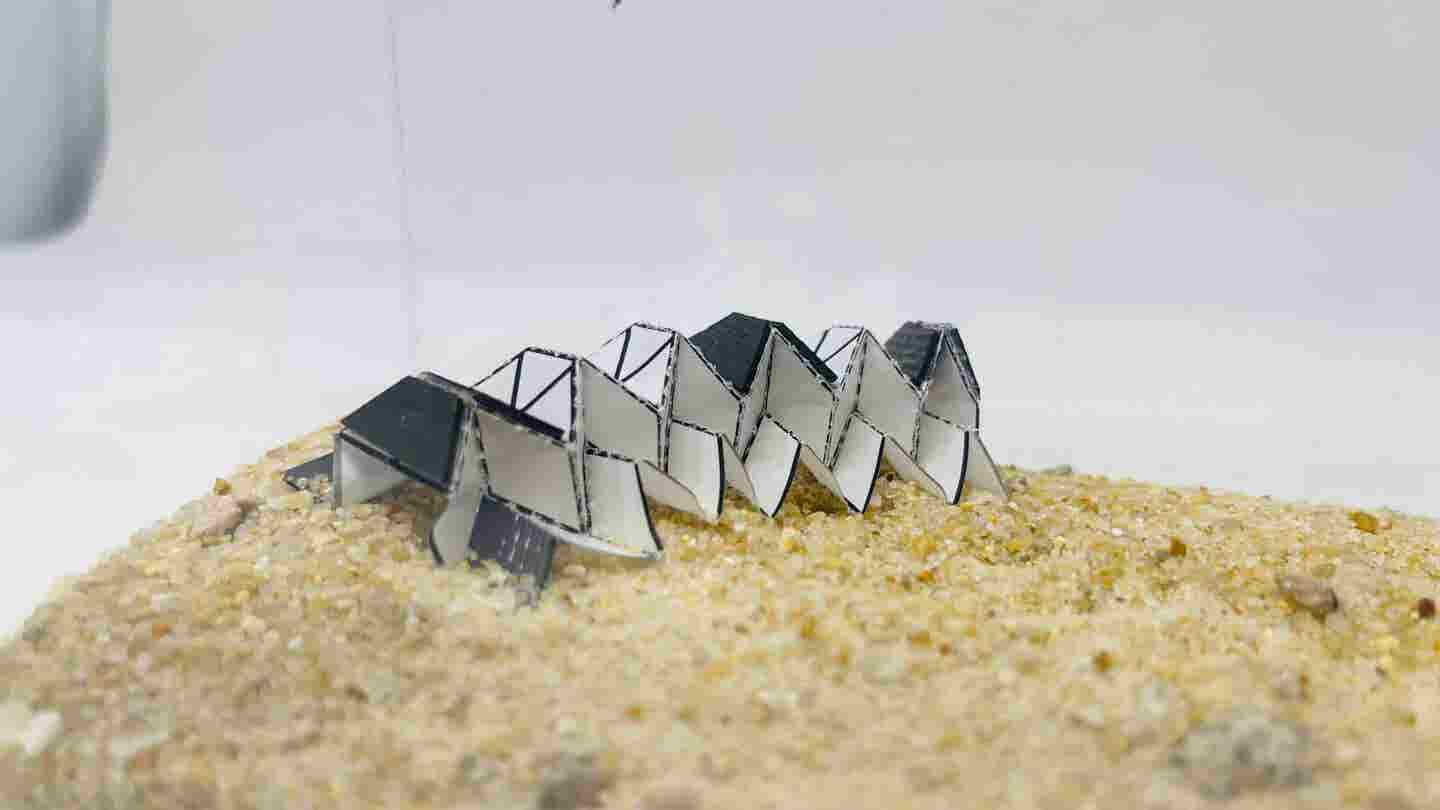Origami robots with magnetic muscles could revolutionize medicine delivery
Researchers 3D print magnetic “muscles” that power foldable origami robots for medical and soft robotics applications.

A soft crawling robot designed using the Miura-Ori origami pattern moves through the action of thin magnetic rubber films embedded in its darker sections.(CREDIT: NCSU)
The next generation of soft robots might be folding and sliding as effortlessly as living tissue, say a team of engineers who have created "magnetic muscles" with 3D printing. Filling elastic, flexible materials with magnetic particles, they built lightweight actuators that curl, twist, and shrink in a magnetic field — the same way biological muscles do.
Researchers at North Carolina State University, in a group led by Xiaomeng Fang of the Wilson College of Textiles, described their breakthrough in Advanced Functional Materials. The novel approach combines material science, origami design, and magnetic engineering. It transfers motion to structures that were previously too fragile or too heavy to support traditional motors.
Printing Muscles That Move
Surrounding this core is a thin elastomer film — a soft rubber-like material — filled with small ferromagnetic particles sensitive to magnetic fields. Magnetizing the film causes it to shrink or bend, producing motion akin to muscle tissue. The challenge was how to fit enough magnetic particles into the elastomer without compromising its flexibility or preventing it from curing in 3D printing.
Usually, there are so many particles that the liquid material darkens, which will soak up the ultraviolet light used to cure it. Fang's team solved this by putting a heated plate underneath the print bed. The extra heat made the material cure even when there was a high particle concentration.
"Adding the hot plate was the solution to being able to print with a much, much higher ferromagnetic particle concentration than usual, which was the breakthrough," Fang said. "More particles that you can use, the greater magnetic force you can generate."
This approach let the films hold much more magnetic material than earlier versions. The films also produced greater power and moved more quickly — traits that are essential for future applications in medicine and robotics.
Origami Meets Robotics
When printed, these "muscle" films were bonded onto origami structures — folded geometric shapes that have the ability to fold from flat pieces into intricate 3D structures. The Miura-Ori pattern, which is one of the patterns used, is most famous for being extremely effective when it comes to folding and unfolding. By bonding the films onto specified folds, the researchers could precisely command how and when the origami robot would move.
Within one demonstration, the team built a biomedical robot that would deliver medicine to ulcers in the stomach. Small and collapsed, it would be swallowed in its collapsed form, and then expand inside the body when triggered by an external magnetic field. Using a mock model of the stomach filled with warm water, the team guided the robot to its destination, opened it out, and demonstrated repeated drug release.
Unlike stiff motorized or wired robots, this magnetic origami robot moved forward quietly and nonharmfully — all remotely manipulated from outside the body.
Fang explained that this method "allows us to deposit the thin film directly onto key components of the origami robot without reducing its surface area significantly." This enables the creation of small, flexible devices. Despite their size, they can still perform intricate motions.
Crawling Forward
The scientists also developed a second model: a crawling robot powered by the same magnetic films. They placed the films over specific panels of a Miura-Ori-based structure. This setup produced a motion cycle where the front lifted and the back shortened. Each pulse of the magnetic field triggered the movement. When the field turned off, the return of the robot to its original shape kicked it forward, producing a step-like mechanism.
This was a clever but straightforward design that enabled the robot to walk up more than seven-millimeter high obstacles and move across different surfaces, including sand. The motion speed could be regulated by adjusting the frequency or strength of the magnetic field.
Altogether, the crawling crawler and biomedical drug carrier show how soft magnetic actuation can be combined with origami geometry. "There are many other types of origami structures that these muscles can actuate," Fang said. "They can be applied to solve problems in problems ranging from biomedicine to astrobiology."
A Step Toward Smarter Soft Robots
The study is a breakthrough for soft robotics — a nascent technology that aims to create more life-like motion in machines than in traditional robots. Since the new "magnetic muscles" are flexible, thin, and light, they can be mounted directly onto delicate systems without stiffening or padding them out.
Earlier magnetic actuators had small stiff magnets attached on the surface of a robot as adhesive glue, limiting the smoothness and accuracy with which they could move. The new films do away with this by embedding the magnetic material throughout the structure. That allows for precise control of motion at specific folds or joints, providing engineers with unprecedented freedom of design.
Practical Implications of the Research
The ability to print magnetic muscles in 3D will have a transformative impact on several industries. In medicine, tiny collapsible robots could travel through the body to deliver drugs or collect tissue samples. They could even perform micro-surgeries. All of their movements would be controlled by magnetic fields from outside the body. Because the materials are soft and biocompatible, they could also enable treatments for ulcers or tumors that are noninvasive, reducing the amount of surgery.
Apart from medicine, these soft actuators would have some uses in search-and-rescue missions or space exploration. Transport robots that fold, unfolding to travel over unstable terrain, could reach places too dangerous or inaccessible for people.
As Fang described, the field of soft robotics is new but rapidly expanding. Advances to come will include smoothing out the control systems, increasing the lifetime of materials, and incorporating other responsive materials — such as heat- or light-responsive materials — for even more flexible robots.
With ongoing development, these magnetic origami robots could become a cornerstone of robotic and biomedical design in the future.
Research findings are available online in the journal Advanced Functional Materials.
Related Stories
- Engineers reinvent the parachute using Japanese paper-cutting art Kirigami
- Origami paper sensors could help early detection of infectious diseases
- Autonomous microrobot sets new standard for precision surgery deep inside the body
Like these kind of feel good stories? Get The Brighter Side of News' newsletter.
Rebecca Shavit
Science & Technology Journalist | Innovation Storyteller
Based in Los Angeles, Rebecca Shavit is a dedicated science and technology journalist who writes for The Brighter Side of News, an online publication committed to highlighting positive and transformative stories from around the world. With a passion for uncovering groundbreaking discoveries and innovations, she brings to light the scientific advancements shaping a better future. Her reporting spans a wide range of topics, from cutting-edge medical breakthroughs and artificial intelligence to green technology and space exploration. With a keen ability to translate complex concepts into engaging and accessible stories, she makes science and innovation relatable to a broad audience.



